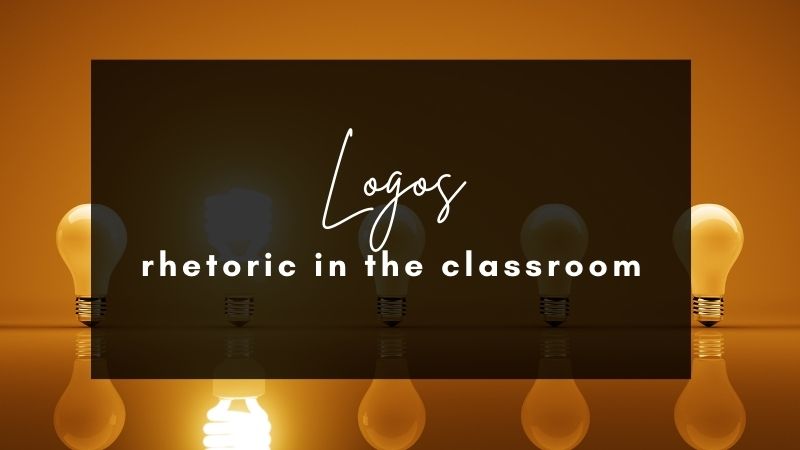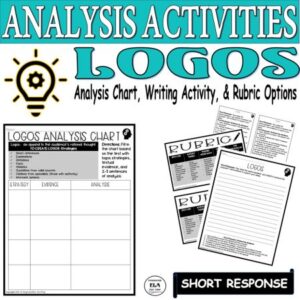When it comes to Teaching Rhetorical Analysis, we need to start out teaching with a Rhetorical Appeals Definition. Rhetorical Appeals Definition: techniques and strategies used for a specific purpose in language (rhetoric) that focus on logic, emotion, and/or credibility.
Students need this starting point of a rhetorical appeals definition because rhetorical analysis in itself is complex, difficult, and time-consuming, but it is also necessary.
We live in a world motivated by emotions, and some rhetoric definitely utilizes more emotional language than any other appeal; however, argumentation should be built on the foundation of Logos, the logical appeal.
Keep reading for an Easy Rhetorical Appeals Definition & 7 Types of Logos!!
Need help with Test Prep? Check out this FREE Pack of 3 Test Prep Activities to help students achieve success on standardized tests!

Rhetorical Appeals Definition: Logos
When you teach the Rhetorical Appeals Definition, also be sure to define Logos. Logos is an appeal to the audience’s rational thought by using facts and statistics, but it can come in many forms. Helping students to identify these forms is vital as they should not simply say “LOGOS” a million times when they are analyzing rhetoric….which they are apt to do 🙂
7 Types of Logos
1. Facts:
When examining an argument or a piece of rhetoric, students need to look for facts. Facts are true things that happen: events, stories, examples, etc. They must be completely true, unbiased, and tested. You many need to help students as they research “facts.” You should be able to certify that facts are true by fact-checking. Just making a statement is not a fact; facts require EVIDENCE. This evidence should be reliable, meaning it has been tested time and time again. One instance in a random article does not a fact make. You can help students to discover facts by teaching them to research by using various sources from multiple viewpoints.
2. Statistics:
Statistics represents a collection of data and information. It is organized and relayed in a way people can understand. Unlike a single instance, statistics is a group of multiple instances and facts that allow us to see trends. You can’t argue with statistics, but you can analyze what they mean. Too often statistics are arranged in a way that promotes a certain perspective; instead, students should be taught to examine and analyze the numbers deeply and not accept conclusions. We need to teach our students to think beyond what is merely presented; correlation does NOT equal causation. Checking out analysis of statistics from multiple sources allows for a better understanding of the data’s meaning.
3. Citations from Specialists (those with authority):
Citations from experts can be a form of logic; however, we must be careful. Simply accepting a citation just because someone has a certain type of education, certification, or experience is not at all logical. You can cite experts, but those people should use evidence, not merely speculation.
4. Explanations/Definitions:
Using a definition from a specific text can be helpful when creating an argument. It helps the audience to understand what the speaker or writer is trying to say. Now, checking out the definitions is part of the rhetorical analysis. Someone could provide a good solid definition that has been verified over time, or someone could utilize a definition that has changed over time. Definitions can change, because language changes. More than anything, the use of definitions can help the audience get on the same page of the person creating the rhetoric.
5. Quotations from Valid Sources:
By valid, I mean correct and verifiable. Valid sources have been tested as true over a specific time-span, and the validity should be buttressed by evidence. Using a quote from a famous historical figure, a philosopher, or an everyday teacher can further the rhetoric as it helps to connect the audience with the ideas of people who have relatable ideas. Those ideas, however, should be logical and supported by facts. Additionally, the quotations should be correctly quoted and cited. So many times, the quotes are taken out of context or incorrectly worded. Solid rhetorical analysis requires in-depth examination and documentation.
If you need readymade worksheets to help you teach a rhetorical appeals definition for logos, click below!
6. Informed Opinions:
One could interview me about teaching English as I have the experience, data, and knowledge to say something concerning this topic. I do not, however, have vast knowledge about basketball or basket-weaving. I would not be a source of an informed opinion on these topics. Verifying what I am saying by using factual evidence in conjunction with my views remains integral to maintaining a logical appeal throughout the rhetoric.
7. Direct References:
One of the great things about formulating an argument built on the rhetorical appeal of LOGOS is that we can cite and reference everything we say instead of having to rely on someone’s emotional state. More than anything, we need to teach our students to examine every piece of evidence they encounter and ensure that the textual evidence can be actually found in places other than a piece of rhetoric.
TEACH HOW TO WRITE A RHETORICAL ANALYSIS ESSAY STEP BY STEP
The Case for the Rhetorical Appeal Logos

Despite what the world may say, logic is the most important rhetorical appeal, at least for a critical-thinking audience. It requires actual research and level-headed thought. Instead of appealing to an emotional state, which can change at a whim, it relies on just the facts.
Ultimately, research requires time and energy. It challenges students to think beyond their presuppositions. It necessitates careful thought and commands reason. Thomas Paine, the author of Common Sense, once said, “Reason obeys itself, and ignorance submits to whatever is dictated to it.” I want my students to question everything. Their questions, however, should lead to actual research beyond the first page of a search engine result.
The Value of Knowing the Rhetorical Appeals Definition and Specific Appeals…
As writers regularly engage with rhetorical appeals and strategies as they create their own arguments, we must teach our middle and high school students the value of studying rhetoric for what it is. We need them to read the text, listen to the speech, and dig more deeply into the news article. Simply seeing a title does not lead to greater knowledge or factual information. Otherwise, they will succumb to whatever is dictated to them first or most emphatically…
Want to teach rhetorical analysis for ANY text? Click the bundle below!
7 Steps for Incorporating the Analysis of Rhetorical Appeals: Logos
- Read the rhetoric thoroughly.
- Annotate for logos.
- Determine the type of logos used.
- Check the sources.
- Actually read the cited sources.
- Verify over multiple sources.
- Formulate your thoughts based on the ACTUAL Evidence!
Teach the Rhetorical Appeals Definition and Rhetorical Analysis Writing for 8 Historical Texts
This Distance Learning Rhetorical Appeals Definition and Rhetorical Analysis Writing BUNDLE includes a rhetorical analysis example in every lesson and is helpful for students when creating thesis statements, outlining essays, examining nonfiction / informational texts, writing short responses, and analyzing rhetorical appeals (logos, pathos, and ethos). Teach the rhetorical appeals definition and rhetorical analysis step by step in your physical or online learning classroom!
The following texts are in this bundle:
- “A Modest Proposal”
- “Declaration of Independence”
- “Declaration of Sentiments”
- “Gettysburg Address”
- “Ain’t I a Woman”
- “Sinners in the Hands of an Angry God”
- Florence Kelley Child Labor Speech
- “Give Me Liberty or Give Me Death”
Check out my store Integrated ELA Test Prep for more help as you teach the Rhetorical Appeals Definition and Rhetorical Analysis Writing!








